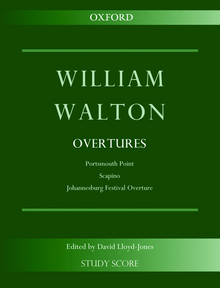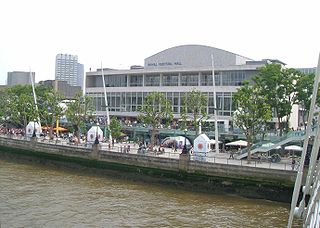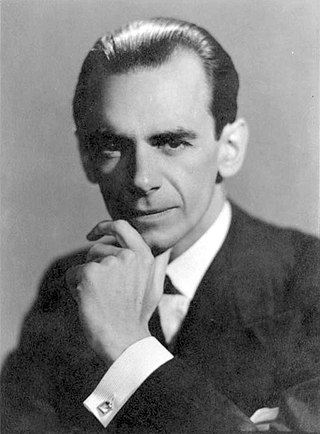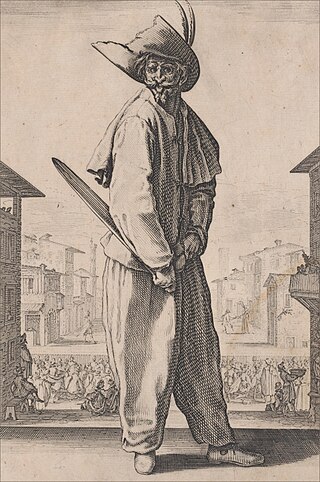
Johannesburg Festival Overture is a composition for orchestra by the English composer William Walton, commissioned to mark the seventieth anniversary of Johannesburg in 1956. It is a short, lively piece, fast-moving throughout.

Johannesburg Festival Overture is a composition for orchestra by the English composer William Walton, commissioned to mark the seventieth anniversary of Johannesburg in 1956. It is a short, lively piece, fast-moving throughout.
In 1956, to celebrate the seventieth anniversary of the founding of Johannesburg, the city organised a festival. Leading performers were engaged including Margot Fonteyn, the La Scala company, the London Symphony Orchestra (LSO), and as soloists Yehudi Menuhin, Andrés Segovia and Pierre Fournier and as conductors Sir Malcolm Sargent and Guido Cantelli. [1] Among the works the LSO scheduled for its five concerts was Walton's First Symphony, [2] but Ernest Fleischmann, the musical director of the festival, also wanted a new Walton piece for the opening concert. He approached the composer in January 1956 with a commission for an orchestral work. [3] He suggested that the piece should include some African themes, and sent Walton some Bantu melodies. [4] Walton sent for recordings of African music from the African Music Society, [3] and worked on the piece at his home in Ischia from February until the end of May 1956. [4] He incorporated the main theme from Jean Bosco Mwenda's "Masanga", which had been released on record earlier in the decade. [5] Also included was a theme from Ruanda-Urundi, "Nimuze". [6]
Walton described the overture to his publisher as "a non-stop gallop ... slightly crazy, hilarious and vulgar". [7] Walton's biographer Michael Kennedy calls it "a seven-minute Rossinian romp". [8]
Sargent conducted the South African Broadcasting Corporation Symphony Orchestra on 25 September 1956 at Johannesburg City Hall in the concert that opened the festival. [9] Efrem Kurtz introduced the work to Britain in a Liverpool Philharmonic concert on 13 November 1956 at the Philharmonic Hall. [9] Sargent conducted the first London performance, with the BBC Symphony Orchestra at the Royal Festival Hall on 23 January 1957. [9] The American premiere was given by the Boston Symphony Orchestra conducted by Charles Munch on 15 March 1957. [10]
The work is scored for three flutes (third doubling piccolo), two oboes, cor anglais, three clarinets in A, three bassoons (third doubling contrabassoon) – four horns in F, three trumpets in B-flat, three trombones, tuba – timpani, three or four percussion (side drum, cymbals, suspended cymbal, bass drum, xylophone, tambourine, triangle, tenor drum, maracas, rumba sticks, castanets, glockenspiel) – harp – strings. [11]
The work is a rondo, fast-paced throughout. Its first tempo marking is presto capriccio; after a very small ritardando the tempo becomes vivacissimo, which accelerates into a prestissimo. The key is D. [12]
Oxford University Press published an 84 page study score in 1958. The score, edited by David Lloyd-Jones, is included in the William Walton Edition, in volume 14, "Overtures". [11] Vilém Tauský arranged a reduced orchestra version in 1957. [13]
The composer recorded the work with the Philharmonia Orchestra on 26 March 1957. [14] Later recordings:
| Orchestra | Conductor | Release date |
|---|---|---|
| New York Philharmonic | Andre Kostelanetz | 1961 |
| National Youth Orchestra of New Zealand | Ashley Heenan | 1967 |
| Royal Liverpool Philharmonic | Sir Charles Groves | 1969 |
| London Philharmonic | Bryden Thomson | 1991 |
| Radio-Sinfonieorchester Basel | Erich Schmid | 1996 |
| English Northern Philharmonia | Paul Daniel | 1996 |

Sir William Turner Walton was an English composer. During a sixty-year career, he wrote music in several classical genres and styles, from film scores to opera. His best-known works include Façade, the cantata Belshazzar's Feast, the Viola Concerto, the First Symphony, and the British coronation marches Crown Imperial and Orb and Sceptre.

The London Symphony Orchestra (LSO) is a British symphony orchestra based in London. Founded in 1904, the LSO is the oldest of London's symphony orchestras. The LSO was created by a group of players who left Henry Wood's Queen's Hall Orchestra because of a new rule requiring players to give the orchestra their exclusive services. The LSO itself later introduced a similar rule for its members. From the outset the LSO was organised on co-operative lines, with all players sharing the profits at the end of each season. This practice continued for the orchestra's first four decades.

The London Philharmonic Orchestra (LPO) is one of five permanent symphony orchestras based in London. It was founded by the conductors Sir Thomas Beecham and Malcolm Sargent in 1932 as a rival to the existing London Symphony and BBC Symphony Orchestras.

Sir Harold Malcolm Watts Sargent was an English conductor, organist and composer widely regarded as Britain's leading conductor of choral works. The musical ensembles with which he was associated included the Ballets Russes, the Huddersfield Choral Society, the Royal Choral Society, the D'Oyly Carte Opera Company, and the London Philharmonic, Hallé, Liverpool Philharmonic, BBC Symphony and Royal Philharmonic orchestras. Sargent was held in high esteem by choirs and instrumental soloists, but because of his high standards and a statement that he made in a 1936 interview disputing musicians' rights to tenure, his relationship with orchestral players was often uneasy. Despite this, he was co-founder of the London Philharmonic, was the first conductor of the Liverpool Philharmonic as a full-time ensemble, and played an important part in saving the Royal Philharmonic Orchestra from disbandment in the 1960s.

Sir Herbert Hamilton Harty was an Irish composer, conductor, pianist and organist.
The Viola Concerto by William Walton was written in 1929 and first performed at the Queen's Hall, London on 3 October of that year by Paul Hindemith as soloist and the composer conducting. It had been written with the violist Lionel Tertis in mind, and he took the work up after initially rejecting it. The concerto established Walton as a substantial figure in British music and has been recorded by leading violists internationally. Walton revised the instrumentation of the concerto in 1961, lightening the orchestral textures.

Façade is a series of poems by Edith Sitwell, best known as part of Façade – An Entertainment in which the poems are recited over an instrumental accompaniment by William Walton. The poems and the music exist in several versions.
The Symphony No. 2 by William Walton was written between 1957 and 1960, and premiered in September 1960. It received a mixed reception at first: some critics thought Walton's music old-fashioned. Subsequently it has been re-evaluated and praised. The work was first performed by the Royal Liverpool Philharmonic Orchestra, conducted by John Pritchard and was first recorded by the Cleveland Orchestra, conducted by George Szell. It has subsequently been recorded by conductors from Britain, the US and elsewhere.

In the South (Alassio), Op. 50, is a concert overture composed by Edward Elgar during a family holiday in Italy in the winter of 1903 to 1904. He was working on a symphony, but the local atmosphere inspired him instead to write what some have seen as a tone poem, with an Italian flavour. At about 20 minutes' duration it was the composer's longest sustained orchestral piece to that time.

James Muir Mathieson, OBE was a British musician whose career was spent mainly as the musical director for British film studios.
John Douglas Louis Veale was an English classical composer.
The Symphony No. 1 in B♭ minor is one of two symphonies by the English composer William Walton. The composer had difficulty in completing the work, and its first public performance was given without the finale, in 1934. The complete four-movement work was premiered the following year.

Orb and Sceptre is a march for orchestra written by William Walton for the coronation of Queen Elizabeth II in Westminster Abbey, London, on 2 June 1953. It follows the pattern of earlier concert marches by Elgar and Walton himself in consisting of a brisk opening section followed by a broad melody in the middle, trio, section and a return to the lively first theme to conclude the piece after a second appearance of the big tune.

The conductor Malcolm Sargent's career as a recording artist began in the days of acoustic recording, shortly before the introduction of the microphone and electrical recording, and continued into the stereo LP era. He recorded prolifically from 1924 until 1967, the year of his death.
The English conductor Sir Adrian Boult was a prolific recording artist. Unlike many musicians, he felt at home in the recording studio and actually preferred working without an audience. His recording career ran from November 1920, when working with Diaghilev's Ballets Russes he recorded the ballet music, The Good-Humoured Ladies, to December 1978, when he made his final recording of music by Hubert Parry.
William Walton's Cello Concerto (1957) is the third and last of the composer's concertos for string instruments, following his Viola Concerto (1929) and Violin Concerto (1939). It was written between February and October 1956, commissioned by and dedicated to the cellist Gregor Piatigorsky, the soloist at the premiere in Boston on 25 January 1957.

Scapino is a short work for large orchestra by William Walton, described by the composer as a "comedy overture". It was commissioned by the Chicago Symphony Orchestra and was first performed in 1941. A revised version was premiered in 1950.
William Walton's Partita for Orchestra is a three-movement work for large orchestra, composed for, dedicated to and first performed by the Cleveland Orchestra and its conductor George Szell. The work was composed in 1957 and premiered on 30 January 1958.
Siesta is a short piece for small orchestra, written by William Walton and premiered in 1926. It was later used for a ballet by Frederick Ashton. Walton was a devotee of Italy, and its influence is apparent in this work.
In Honour of the City of London is a 1937 cantata by William Walton for mixed chorus and orchestra. The text is by the 15th–16th-century poet William Dunbar. It was written for the Leeds Triennial Festival for which Walton had composed Belshazzar's Feast in 1931, but it failed to gain the popularity of the earlier work and is comparatively infrequently performed.